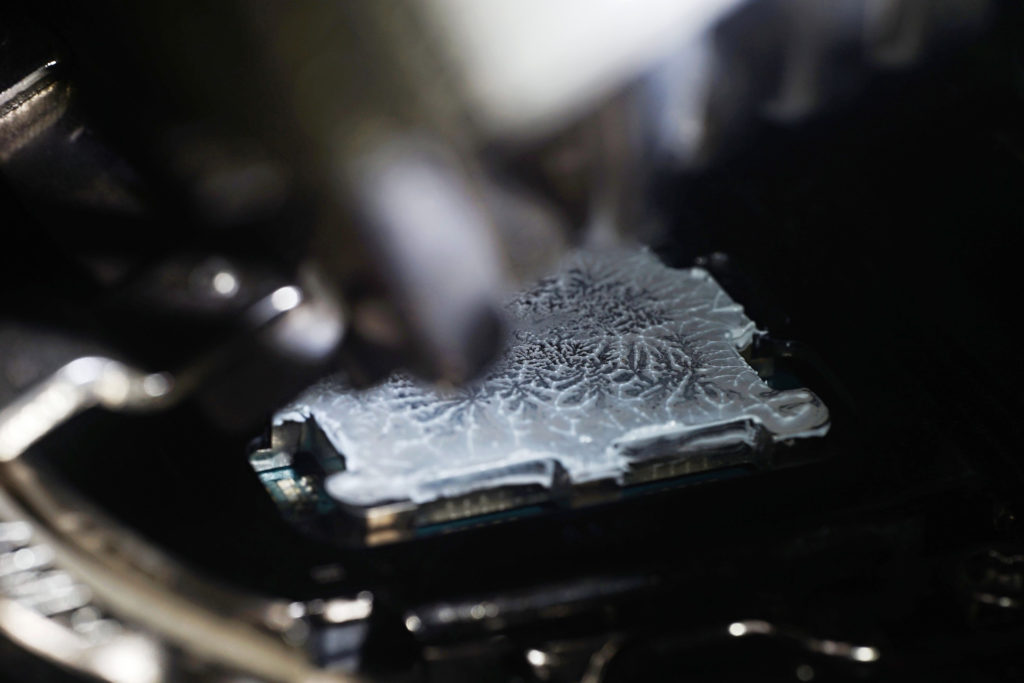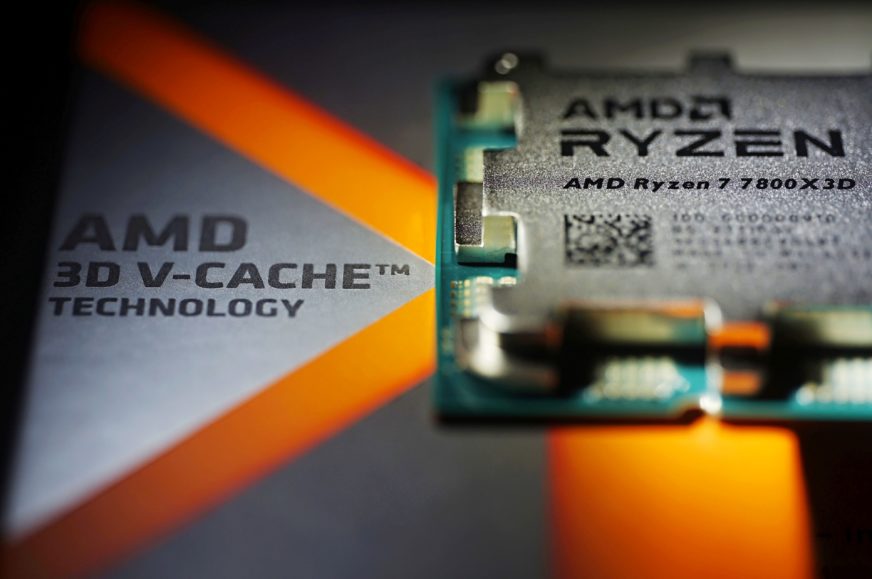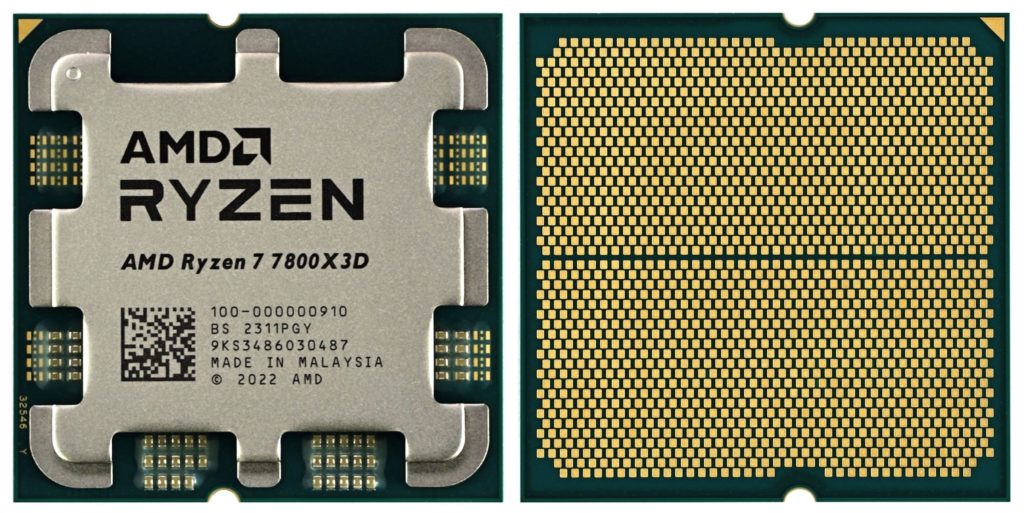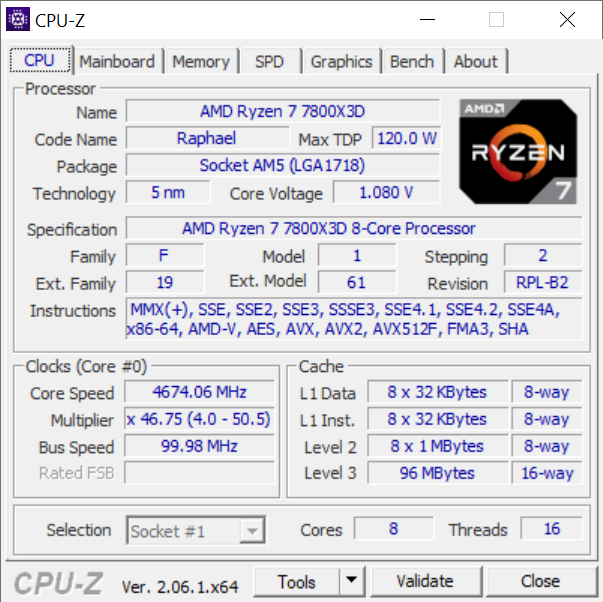AMD Ryzen 7 7800X3D in detail
The most popular Ryzen 7000 with 3D V-cache obliterates competition in its targeted environment. Intel doesn’t measure up to the Ryzen 7 7800X3D in a comparable price range in terms of speed, and even if someone disregards price and sees the Core i9-13900K(S) as a an apt competitor, when comparing power draw, everyone’s appetite for Intel will go away. Their efficiency is… incomparable, as each is at a different end of the spectrum.
AMD Ryzen 7 7800X3D in detail
It’s a bit of a Ryzen 7 5800X3D replay based on AMD’s AM5 platform and a new architecture (Zen 4, which also has the 5nm manufacturing node associated with it). The main role for the Ryzen 7 7800X3D is played by the same modification – the addition of a second piece of silicon on the CCD chiplet with the CPU cores, which transparently increases the L3 cache from the original 32 MB to 96 MB.
In terms of speed, the R7 7800X3D has the advantage (over the R7 5800X3D) of a higher IPC (according to selected AMD internal tests by an average of 13%) and also higher all-core boost clock speeds, depending on the load by 300–400 MHz. Single-core boost is also faster, increasing application performance across generations in tasks that use only a single thread. But the Ryzen 7 7800X3D still lags well behind models with “regular” L3 cache in this regard. This is because the technology used to connect the chiplet with the 3D V-cache cannot handle as high a voltage as could be used in the rest of the chiplet.
A greater, tighter maximum voltage limit naturally means lower clock speeds, but these are still higher than with the Ryzen 7 5800X3D at all levels, which also means higher bandwidth and lower L3 (but also L1 and L2) cache latencies, the benefits of which are mainly discussed around gaming. These access a large amount of data from RAM, for which the CPU waits longer than from the L3 cache, which usually cannot hold everything necessary though. In the case of Ryzen processors with 3D V-cache, the situation is better, the cache capacity is significantly larger.
If such a large cache is well implemented, the negative impact of lower clock speeds can be outweighed and ultimately higher gaming performance can be achieved. That’s why this processor is associated with the word “gaming” – it should have the upper hand in such an environment. And not just in terms of speed, but also in terms of efficiency, which was already a cut above with the Ryzen 7 5800X3D. With the Ryzen 7 7800X3D, the gaming performance per watt ratio is pushed to a higher level by both a more efficient manufacturing node – 5 nm (Zen 4/R7 7800X3D) vs. 7 nm (Zen 3/ R7 5800X3D), and the fact that AMD set more efficient clock speeds, which was kind of unavoidable as well.
The topic of cooling…
The Ryzen 7000s, including the R7 7800X3D, have a slightly smaller CCD chiplet area with a higher heat flux density. Combined with the poorer heat conduction properties of AMD Raphael processors’ IHS compared to older AM4 models, and the generally worse heat dissipation of X3D processors (through the extra cachce layer), a more powerful cooler is then needed at the same power draw to achieve the same temperature.
However, to make do with what you already have or to avoid having to buy very expensive coolers, AMD has significantly reduced power draw. So why is there a TDP increase stated in the parameters – 120 W (R7 7800X3D) instead of 105 W, which has a higher power draw?

… and TDP does not equal power draw
The increase in TDP of the Ryzen 7 7800X3D is probably related to the worse heat dissipation. It’s possible that this is why AMD lists a higher TDP while reducing power draw. TDP (Thermal Design Power) is often mistakenly interchanged with the power draw value. TDP can be significantly higher. If heat dissipation from the chip is complicated (which is sort of the case with the Ryzen 7 7800X3D), then a cooler with a higher TDP than the electrical power of the device being cooled is needed.
While the maximum power draw of the Ryzen 7 7800X3D is only around 80W, you’ll need a cooler that’s designed for at least 120W to keep it at bay. And for any fan speed reduction to achieve quiet operation, the TDP of the cooler will need to be even higher. Besides the higher voltage, higher temperature is perhaps harmful for X3D Ryzen 7000s, and it’s good to stay away from 95 °C (common for models with 32 MB cache). This is also indicated by the lowered maximum temperature for the Ryzen 7 7800X3D (in AMD’s specs) to 89 °C.
| Manufacturer | AMD | AMD | Intel | |
| Line | Ryzen 7 | Ryzen 7 | Core i7 | |
| SKU | 7800X3D | 7700X | 13700K | |
| Codename | Raphael | Raphael | Raptor Lake | |
| CPU microarchitecture | Zen 4 | Zen 4 | Golden Cove (P) + Gracemont (E) | |
| Manufacturing node | 5 nm + 6 nm + 7 nm | 5 nm + 6 nm | 7 nm („Intel 7 Ultra“) | |
| Socket | AM5 | AM5 | LGA 1700 | |
| Launch date | 04/06/2023 | 09/27/2022 | 10/20/2022 | |
| Launch price | 449 USD | 399 USD | 409 USD | |
| Core count | 8 | 8 | 8+8 | |
| Thread count | 16 | 16 | 24 | |
| Base frequency | 4.2 GHz | 4.5 GHz | 3.4 GHz (P)/2.5 GHz (E) | |
| Max. Boost (1 core) | 5.0 GHz (unofficially 5.05 GHz) | 5,4 GHz (unofficially 5,51 GHz) | 5.4 GHz (P)/4.2 GHz (E) | |
| Max. boost (all-core) | N/A | N/A | 5.3 GHz (P)/4.2 GHz (E) | |
| Typ boostu | PB 2.0 | PB 2.0 | TBM 3.0 | |
| L1i cache | 32 kB/core | 32 kB/core | 32 kB/core (P), 64 kB/core (E) | |
| L1d cache | 32 kB/core | 32 kB/core | 48 kB/core (P), 32 kB/core (E) | |
| L2 cache | 1 MB/core | 1 MB/core | 2 MB/core (P), 4× 4 MB/4 cores (E) | |
| L3 cache | 1× 96 MB | 1× 32 MB | 1× 30 MB | |
| TDP | 120 W | 105 W | 125 W | |
| Max. power draw during boost | 162 W (PPT) | 142 W (PPT) | 253 W (PL2) | |
| Overclocking support | No | Yes | Yes | |
| Memory (RAM) support | DDR5-5200 | DDR5-5200 | DDR5-5600/DDR4-3200 | |
| Memory channel count | 2× 64 bit | 2× 64 bit | 2× 64 bit | |
| RAM bandwidth | 83.2 GB/s | 83.2 GB/s | 89,6 GB/s/51,2 GB/s | |
| ECC RAM support | Yes (depends on motherboard support) | Yes (depends on motherboard support) | Yes (with vPro/W680) | |
| PCI Express support | 5.0 | 5.0 | 5.0/4.0 | |
| PCI Express lanes | ×16 + ×4 + ×4 | ×16 + ×4 + ×4 | ×16 (5.0) + ×4 (4.0) | |
| Chipset downlink | PCIe 4.0 ×4 | PCIe 4.0 ×4 | DMI 4.0 ×8 | |
| Chipset downlink bandwidth | 8,0 GB/s duplex | 8,0 GB/s duplex | 16.0 GB/s duplex | |
| BCLK | 100 MHz | 100 MHz | 100 MHz | |
| Die size | 66,3 + 118 + 36 mm² | 66,3 mm² + 118 mm² | ~257 mm² | |
| Transistor count | 6,57 + 3,37 + 4,7 bn. | 6,57 + 3,37 bn. | ? bn. | |
| TIM used under IHS | Solder | Solder | Solder | |
| Boxed cooler in package | No | No | No | |
| Instruction set extensions | SSE4.2, AVX2, FMA, SHA, VAES (256-bit), AVX-512, VNNI | SSE4.2, AVX2, FMA, SHA, VAES (256-bit), AVX-512, VNNI | SSE4.2, AVX2, FMA, SHA, VNNI (256-bit), GNA 3.0, VAES (256-bit), vPro | |
| Virtualization | AMD-V, IOMMU, NPT | AMD-V, IOMMU, NPT | VT-x, VT-d, EPT | |
| Integrated GPU | AMD Radeon | AMD Radeon | UHD 770 | |
| GPU architecture | RDNA 2 | RDNA 2 | Xe LP (Gen. 12) | |
| GPU: shader count | 128 | 128 | 256 | |
| GPU: TMU count | 8 | 8 | 16 | |
| GPU: ROP count | 4 | 4 | 8 | |
| GPU frequency | 400–2200 MHz | 400–2200 MHz | 300–1600 MHz | |
| Display outputs | DP 2.0, HDMI 2.1 | DP 2.0, HDMI 2.1 | DP 1.4a, HDMI 2.1 | |
| Max. resolution | 3840 × 2160 px (60 Hz) | 3840 × 2160 px (60 Hz) | 7680 × 4320 (60 Hz) | |
| HW video encode | HEVC, VP9 | HEVC, VP9 | HEVC, VP9 | |
| HW video decode | AV1, HEVC, VP9 | AV1, HEVC, VP9 | AV1, HEVC, VP9 |
- Contents
- AMD Ryzen 7 7800X3D in detail
- Methodology: performance tests
- Methodology: how we measure power draw
- Methodology: temperature and clock speed tests
- Test setup
- 3DMark
- Assassin’s Creed: Valhalla
- Borderlands 3
- Counter-Strike: GO
- Cyberpunk 2077
- DOOM Eternal
- F1 2020
- Metro Exodus
- Microsoft Flight Simulator
- Shadow of the Tomb Raider
- Total War Saga: Troy
- Overall gaming performance
- Gaming performance per euro
- PCMark and Geekbench
- Web performance
- 3D rendering: Cinebench, Blender, ...
- Video 1/2: Adobe Premiere Pro
- Video 2/2: DaVinci Resolve Studio
- Graphics effects: Adobe After Effects
- Video encoding
- Audio encoding
- Broadcasting (OBS and Xsplit)
- Photos 1/2: Adobe Photoshop and Lightroom
- Photos 2/2: Affinity Photo, Topaz Labs AI Apps, ZPS X, ...
- (De)compression
- (De)encryption
- Numerical computing
- Simulations
- Memory and cache tests
- Processor power draw curve
- Average processor power draw
- Performance per watt
- Achieved CPU clock speed
- CPU temperature
- Conclusion











First of all fantastic review. Would it be possible for you in the future to also include X-Plane 12 and DCS World in your benchmark suite? No one ever tests them and while they are very niche they are extremly CPU heavy, moreso than any other game. That would be awesome to see if you could do that.
Thank you for the useful tips for expanding test applications. X-Plane 12 and DCS World will probably be included, but probably won’t be in the next test yet. The time complexity of the things we do (not only in the processor tests) is hitting a ceiling with the current editorial capabilities. Anyway, I’m putting both games on the list of “things that would be worthwhile to deal with as part of a methodology revision”.
I would like a clarification on something.
“The main role for the Ryzen 7 7800X3D is played by the same modification – the addition of a second piece of silicon on the CCD chiplet with the CPU cores”
Is this line referring to the extra silicon for the 3D V-cache? Or the modification that only the other 2 7000 X3D chips have of a second CCD on the processor?
Yes, the cited quote refers to a chip with 3D V-cache.